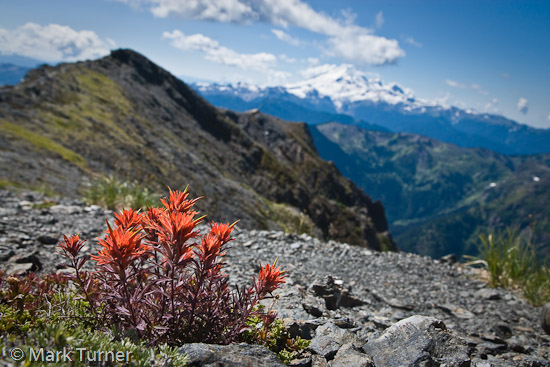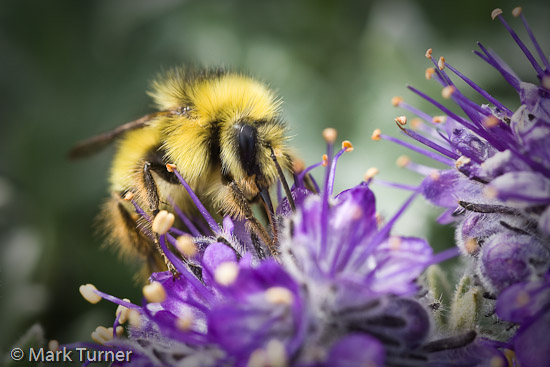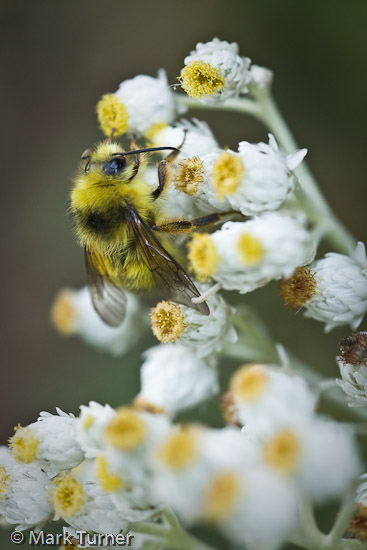Tomyhoi

Sunday was our first really nice day after more than a week of summer that felt more like autumn. The sky cleared and the air warmed to the upper 60s. In short, a perfect day for a hike in the mountains. A couple of weeks previous I’d been up on the side of Mount Larrabee and looked over at Tomyhoi Peak. I decided to go for the reverse view.
I hadn’t been on Tomyhoi since a climbing class trip back in the early 1990s. I set out to go all the way to the summit. It’s about 12 miles round trip with over 4000′ of elevation gain, topping out about 7100′. I hoped there would still be lots of alpine flowers blooming so I carried my big camera, a couple of lenses, and tripod. I also stuck my ice axe on my pack, expecting to need it on the final snow slopes. I hike pretty fast when I’m by myself and gained the first 1000 feet in 30 minutes, the turnoff from Gold Run Pass to Yellow Aster Butte in 45 minutes. Then I slowed down to enjoy the scenery.
But since I really wanted to get all the way to Tomyhoi, I didn’t stop much as I contoured around the basin and climbed up toward Yellow Aster. Then I dropped down the steep switchbacks to the tarns where I stopped to make a few photos and then continued on north. From a distance, Tomyhoi looks like a long gentle slope from the Yellow Aster tarns. As mountains go, I guess it is gentle. But when hiking uphill it certainly seems steeper.
I passed krumholtz subalpine firs and mountain hemlocks, groundcover carpets of kinnikinnik and juniper, fields of lichens studded with sparse heather and huckleberries. I dropped into and climbed back out of a big notch, eventually gaining the ridge. That’s where I found this nice little clump of rock paintbrush, Castilleja rupicola, blooming all by itself. Actually, it was coming up out of some Davidson’s penstemon that had already finished blooming. I made the photo with the camera on the ground, 32mm lens, and hardly able to see through the viewfinder because of the rock blocking my head. That’s Mt. Baker in the background. It’s a high noon shot.
After scarfing down a peanut butter sandwich I continued toward the summit. There’s a well-worn boot track and several other parties were on the route Sunday. The track ends a bit south of the true summit, with another deep notch and significant exposure on both east and west blocking the way. The climbing route contours around the east side, up the snow, through another notch and then up the rock to the summit. I’d been there before, so I thought I could do it again.
I dropped down the scree to the upper flanks of the glacier and pulled out my ice axe. Then I stepped gingerly out onto the snow. My boots would barely kick steps and my axe only went in a couple of inches. That wasn’t a good sign. I proceeded slowly on an uphill traverse, heading for the notch. The snow didn’t get any softer. While the runout below was decent and I was confident I could self arrest if I slipped, I really didn’t feel like falling six miles from the trailhead while traveling alone. I backed out and returned to the scree.
Part of the east flank of the mountain is a broad, nearly flat expanse of scree with lumps of solid rock here and there. I meandered around looking for something blooming. There wasn’t much, but I did find several clumps of silky phacelia, Phacelia sericea. The bees were all over it.

I pulled out my 100mm macro lens, set it for nearly as close as it would focus, and started shooting. If you’ve ever observed bees working flowers, you know that they don’t stay in one place. They’re constantly moving over the clusters of blossoms, usually with their stinger pointed toward the photographer. I don’t usually go for “spray and pray” photography, but with these fast-moving subjects that’s what I did. I shot a lot and ended up with only a very small number of keepers. This is one.
 Insects seemed to be my Sunday subject. Besides the bees on phacelia, I found a moth lazing on moss campion and a butterfly nearly motionless on an alpine golden aster. Then, when I was nearly back to the trailhead I saw a bee completely still on pearly everlasting by the trail. The air had cooled and the trail was in shadow, so I think the bee was going to be there all night.
Insects seemed to be my Sunday subject. Besides the bees on phacelia, I found a moth lazing on moss campion and a butterfly nearly motionless on an alpine golden aster. Then, when I was nearly back to the trailhead I saw a bee completely still on pearly everlasting by the trail. The air had cooled and the trail was in shadow, so I think the bee was going to be there all night.
I had time to pull out the tripod, change lenses, and shoot multiple frames of the same bee. It was getting pretty dark, and although the air was fairly calm, I ended up cranking the ISO up to 800 to get 1/30 sec. at f/6.3. Even so, there was enough movement of the flowers that not all the frames were as sharp as I would like.
Insects aren’t my major subject matter, but it’s fun to work with something different every now and then. I’m pleased to have gotten a few nice frames of these very important members of the animal kingdom. They fill a valuable ecological niche.


Great pictures. I too find that many shots usually equal one or two keepers.